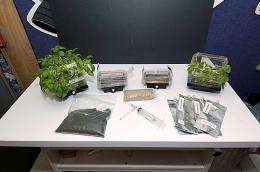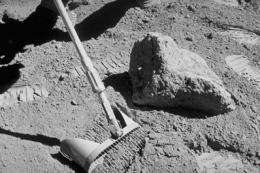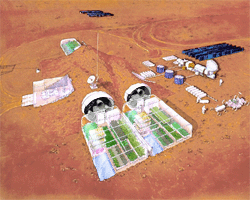Greening the Moon and Mars

Future missions to the Moon or Mars could use plants as bio-harvesters to extract valuable elements from the alien soils.
Future manned missions to the Moon or Mars could use plants as bio-harvesters to extract valuable elements from the alien soils, researchers say.
Now they hope to launch new experiments to follow up on tests done with plants and lunar regolith during NASA's Apollo program that landed men on the Moon.
Lunar regolith is a loose mixture of dust, soil, broken rock and other related materials that lie on top of solid bedrock. The Apollo-era research showed that returned lunar samples of the regolith did not have toxins or contain alien life-form contaminants that could threaten plants, animals or humans on Earth. Yet limited use of the precious lunar regolith meant that scientists could not study how well plants fared when grown in regolith.
"In spite of the fact that we absolutely admire the innovative science done in the Apollo era, the question of whether a plant could grow if you plop a seed in lunar regolith hasn't been answered," said Robert Ferl, a geneticist at the University of Florida in Gainesville.
Ferl and Anna-Lisa Paul, another geneticist at the University of Florida, hope to pick up where the Apollo-era experiments left off. Renewed research could take advantage of the powerful tools developed in the past several decades for studying molecular biology and genetics, and see how plants react on a molecular level by turning on or off their genes in response to regolith.
New studies could also push the potential shown in how plants apparently derived some nutrients from lunar regolith. That could go beyond the dreams of lunar agriculture to transform plants into planetary harvesters, and ultimately help sustain human bases on alien soil.
"It's not just about using lunar and Mars regolith to grow plants," Paul explained. "It's about capturing nutrients that might otherwise be lost to us."
The review study of Apollo-era plant experiments was detailed in the April issue of the journal Astrobiology.

Safety first
NASA took great precautions with samples returned during the first manned missions to the Moon by building the Lunar Receiving Lab (LRL) at the Johnson Space Center in Houston. The LRL facility's design intended to ensure that no dangerous contaminants or unknown alien life forms escaped to threaten Earth's biosphere, even as researchers began carrying out biological experiments with the lunar regolith.
Any planetary protection fears faded quickly as the first studies showed that plants did not wither and die from contact with lunar samples. About 35 plant species remained in good health after lunar samples from the Apollo 11 and 12 missions had been rubbed onto the leaves and placed at their base. Similarly, animals did not suffer from any ill effects during exposure to lunar samples.
In fact, one study found that germinated seedlings and plant cultures seemed to enjoy nutritional benefits from the lunar samples. The lunar dust and regolith contained certain elements useful for plant growth, such as iron, magnesium and manganese, even if it mostly lacked necessary elements such as nitrogen, phosphorus, sulfur and potassium.
That pointed to the possibility of using plants to biologically harvest nutrients or minerals from the Moon, and suggested that lunar farms could contribute to life-support beyond just feeding astronauts.
"In one interesting model put out a few years ago, plants would live in low-pressure pods on the surface," Ferl said. "Astronauts or lunar colonists would go out in pressure suits to capture them."
Taking the next step
The plants may have survived and even thrived a small sprinkling or rubbing of lunar material, but researchers say many unknowns remain after the last lunar soil experiments that took place 30 years ago.
For instance, none of the Apollo-era experiments examined how lunar material affected the microorganisms such as bacteria or fungi that normally assist plants in harvesting nutrients. Even microbes from human astronauts might interact with the plant roots in the region of soil known as the rhizosphere.
"You have the colonization of the plant roots by a host of organisms that break down and transport materials," Paul said. "These things facilitate the harvesting of molecules from the substrate in which the plant is growing."

New experiments don't need to wait for a return trip to the Moon, according to the researchers. They already have plans that would require just a few grams of the hundreds of kilograms of lunar regolith collected by NASA.
Just one gram of lunar regolith could support the growth of several Arabidopsis plants related to cabbage and radish, Paul pointed out. That model organism represented the first plant to have its genome sequenced, and so would provide a great baseline for lunar biology experiments.
From Earth to the Moon and Mars
Such testing concepts could also become part of experiments done on the Moon itself, whenever a human base does get established. Those experiments would not only answer questions about basic plant biology, but also provide the seeds of knowledge for developing ecology off of Earth.
"One goal is to use plants for life-support and find out the best means to do that, and [figure out if] plants use lunar resources to do that," Ferl said. "The other question is what the limits of terrestrial life are, and does the Moon's surface represent a place that terrestrial biology can inhabit."
That approach could also help tackle problems related to growing plants in Martian regolith. Some studies on Earth have already tested plant growth in Mars-simulant regolith augmented with certain chemicals, even if a Martian sample has yet to reach Earth.
In the end, the same need to use all available resources and help sustain human colonists would become even greater for a trip to Mars. "Going to Mars is so much more difficult, because the concept of taking all your resources with you for the whole trip becomes more difficult," Paul said. "The drivers that would point toward using plants for life support actually become more crucial."
Planting the seeds
More Earth experiments also could help engineers and scientists better design future orbital or extraterrestrial farms.
"Testing on extreme environments on Earth could be very useful to identify critical design aspects to be fixed prior to build and fly a demonstration system on the [International Space Station]," said Claudio Finetto, an engineering consultant for Thales Alenia Space-Italia in Torino, Italy. Finetto and colleagues Cesare Lobascio and Alessandro Rapisarda calculated that a bio-regenerative life support system with just 20 percent of food re-supplied from Earth would become more convenient for an 18-person moon base inhabited for longer than five years, as opposed to relying on complete food re-supply from Earth.
Their work is detailed in the May-June issue of the journal Acta Astronautica. The Lunar FARM concept also grew out of a post-graduate course in SpacE Exploration and Development Systems (SEEDS) Second Edition at Politecnico di Torino, where Finetto worked with Salvatore Cusumano, Daniele Renzoni, Amir Sabbagh and Cosimo Sinesi.
Even if NASA has scrapped immediate plans to return to the Moon, Finetto agreed that a manned Mars mission could benefit from a self-sustaining approach. He added that a spacecraft greenhouse could support astronauts on the Martian surface just as easily as during the six-month journeys to and from the red planet.
More advanced robots could also reduce the amount of time human astronauts spend on cultivating their plants, according to Finetto.
That still looks a long way off from the Apollo-era experiments with bits of lunar regolith sprinkled atop plants. But someday, robots could maintain a self-sustaining greenhouse orbiting above Mars as human explorers focus on science and exploration down on the surface below.
Provided by Astrobio.net



















